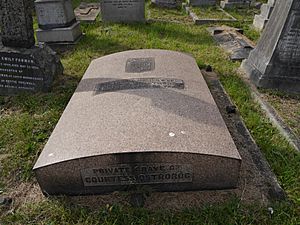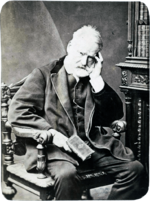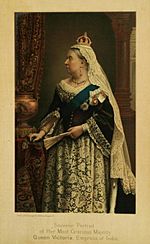Stanisław Julian Ostroróg facts for kids
Quick facts for kids
Count Stanisław Julian Ostroróg
|
|
|---|---|

Ostroróg's grave in Brompton Cemetery
|
|
| Nickname(s) | Walery |
| Born | January 1836 Mohylew, former Commonwealth of Two Nations, now Belarus |
| Died | 31 May 1890 London, England |
| Buried |
Brompton Cemetery, London
|
| Allegiance | The Russian Empire, the United Kingdom, Poland and the Ottoman Empire |
| Service/ |
|
| Years of service | 1852–1857 |
| Rank | Colonel in the Ottoman military |
| Unit | Polish cavalry division of the Ottoman Army |
| Commands held | Adjutant to gen. Władysław Zamoyski |
| Battles/wars | Crimean War |
| Awards | Gold Medal for photography, Paris 1878, 1889 and others |
| Relations | Stanisław, his photographer son, Leon, his jurist son and Stanislas his French ambassador grandson |
| Other work | Portrait photographer known as Walery |
Count Stanisław Julian Ostroróg (1836–1890) was a Polish nobleman who became a famous photographer. He was also a veteran of the Crimean War.
He was known by his professional name, Walery. He took portraits of many important people of his time. These included Queen Victoria, Queen Alexandra of Denmark, Victor Hugo, and Sarah Bernhardt.
After he passed away, his oldest son, Stanisław Julian Ignacy Ostroróg, continued the "Walery" photography business. This happened in London and Paris.
Contents
Early Life and Military Career
Count Stanisław Julian Ostroróg was born in Mohylew. This area was once part of a country called the Commonwealth of Two Nations. Today, it is in Belarus. His family belonged to the Polish Szlachta, which means they were part of the nobility.
His family had to leave their home because of a rebellion against the Russian Empire. They found safety in other countries, like France.
Young Stanisław chose a military career. He trained at a special academy in Saint Petersburg, Russia. He joined the Imperial Guard and became a captain. He fought in the Crimean War. During the war, he joined the British army. He also became a colonel in the Ottoman army.
Some people believe Ostroróg started taking photos during the Crimean War. He might have taken a Daguerreotype (an early type of photo) of the famous poet Adam Mickiewicz in 1855.
After the war, Ostroróg lived in London starting in 1856. He became a British citizen in 1862. He also worked on improving a musical instrument called the "melodina."
Starting a Photography Business

When he was a boy in Paris, Ostroróg met a famous scientist named François Arago. Arago sparked his interest in optics and the new world of photography. Arago helped make photography discoveries available to everyone.
Around 1857, Ostroróg moved to Paris. He tried writing poetry and publishing, but it wasn't very successful. He then returned to London, where he got married and started a family.
In 1864, Ostroróg opened his first photography studio in Marseilles, France. He chose the professional name "Walery" after his wife's name, Waleria. He was a member of the Société française de photographie, a French photography group.
After a war in 1871, he opened another studio in Paris. He took pictures of famous people like Gustave Eiffel (who designed the Eiffel Tower), Ferdinand Lesseps (who built the Suez Canal), Louis Pasteur (a famous scientist), and Victor Hugo (a famous writer).
Later, he opened a studio in London in 1884. His work was published, which helped him become even more famous. His connections with royalty, writers, and actors in Europe helped him get important clients in London.
Photographer to the Queen

Ostroróg first photographed Queen Victoria at Windsor Castle in 1884. The Queen liked him very much. She had more sittings with him, and other members of her family and friends also had their pictures taken by him.
Queen Victoria especially liked his idea of oval brooches. These brooches had her picture printed on enamel and set in brass. They made special gifts from the Queen.
He took many portraits of the Queen, especially showing her as the Empress of India. These pictures were printed on silk and shared widely. Because of this connection, he was allowed to use the title "Photographer to the Queen" on all his studio work. You can see this title on many of his original photos from that time.
Personal Life and Legacy
Stanisław Ostroróg had five children. He passed away suddenly in London on May 31, 1890. He is buried in Brompton Cemetery. His grandson, Stanislas Ostroróg, became a French diplomat and ambassador to India.
Awards and Recognition
Ostroróg won several awards for his photography. Some of his awards include:
- 1873 Vienna "Médaille de Bon Goût" (Medal of Good Taste)
- 1876 Philadelphia "Médaille de Mérite" (Medal of Merit)
- 1878 Paris Gold Medal
- 1883 Amsterdam Gold Medal
- 1884 Nice "Récompense Unique" (Unique Reward)
- 1889 Paris Gold Medal
The Royal Commonwealth Society has a large collection of his "Walery" photographs.
After his death, his son, Stanisław Julian Ignacy Ostroróg (1863-1929), continued his father's photography business in London. Later, his son moved to Paris and became very successful. He took portraits of stars from the Folies Bergère, including Josephine Baker and Mata Hari.
Many major museums and collections around the world hold Walery portraits. These include the Bibliothèque nationale de France, the Victoria and Albert Museum, the National Portrait Gallery, London, and Getty Images.
In 2005, the National Portrait Gallery in London held an exhibition called "Victorian Women." It featured the work of both Stanisław Julian Ostroróg and his son.
Images for kids
-
Queen Alexandra in choker
-
Pedro II of Brazil 1887
See also
- List of Poles








